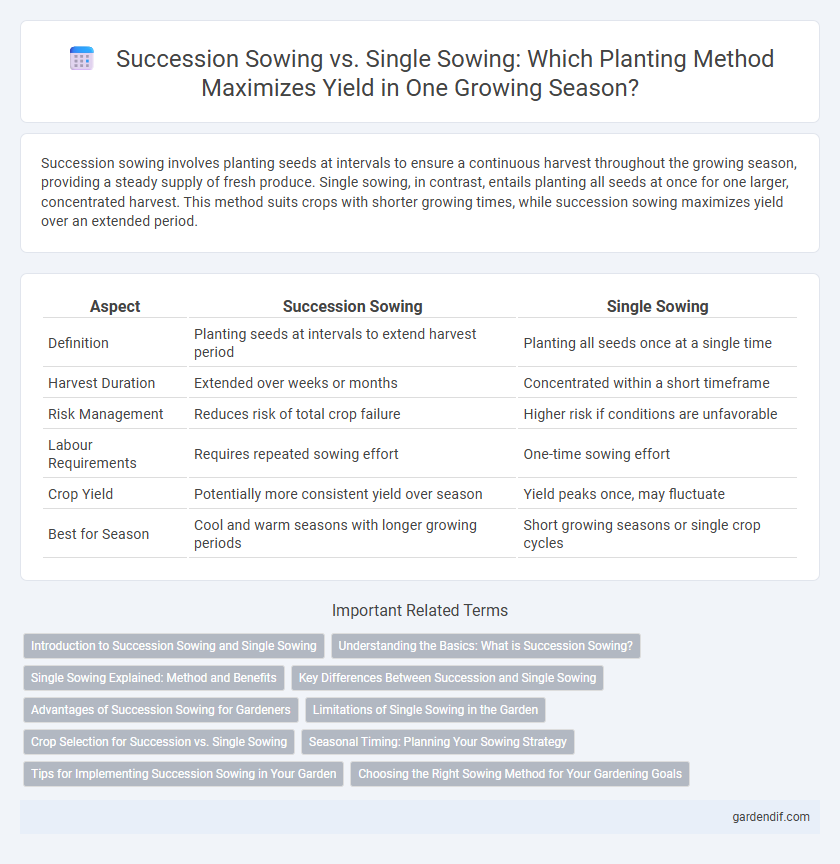
Succession sowing vs Single sowing Illustration
Succession sowing involves planting seeds at intervals to ensure a continuous harvest throughout the growing season, providing a steady supply of fresh produce. Single sowing, in contrast, entails planting all seeds at once for one larger, concentrated harvest. This method suits crops with shorter growing times, while succession sowing maximizes yield over an extended period.
Table of Comparison
| Aspect | Succession Sowing | Single Sowing |
|---|---|---|
| Definition | Planting seeds at intervals to extend harvest period | Planting all seeds once at a single time |
| Harvest Duration | Extended over weeks or months | Concentrated within a short timeframe |
| Risk Management | Reduces risk of total crop failure | Higher risk if conditions are unfavorable |
| Labour Requirements | Requires repeated sowing effort | One-time sowing effort |
| Crop Yield | Potentially more consistent yield over season | Yield peaks once, may fluctuate |
| Best for Season | Cool and warm seasons with longer growing periods | Short growing seasons or single crop cycles |
Introduction to Succession Sowing and Single Sowing
Succession sowing involves planting seeds at intervals to ensure a continuous harvest throughout the growing season, maximizing crop yields and garden productivity. Single sowing refers to planting all seeds at once, which typically results in a concentrated harvest period ideal for crops that do not require staggered production. Understanding the difference between these techniques helps gardeners optimize planting schedules according to crop type and desired harvest timing.
Understanding the Basics: What is Succession Sowing?
Succession sowing involves planting seeds in intervals to ensure a continuous harvest throughout the growing season, maximizing yield and garden productivity. This method contrasts with single sowing, where all seeds are planted at once, resulting in a singular, concentrated harvest period. Understanding succession sowing helps gardeners extend their harvest times and maintain a steady supply of fresh produce.
Single Sowing Explained: Method and Benefits
Single sowing, a precise planting method where seeds are sown individually at specific intervals, enhances seedling growth by providing optimal space for root and shoot development. This technique reduces competition among plants for nutrients, water, and sunlight, leading to stronger, healthier crops with higher yields. Efficient single sowing also facilitates easier weed control, irrigation, and disease management, promoting sustainable and productive seasonal farming.
Key Differences Between Succession and Single Sowing
Succession sowing involves planting crops in intervals to ensure continuous harvests, maximizing yield over an extended season. Single sowing consists of planting once per season, resulting in a concentrated harvest period but less flexibility in crop availability. The key difference lies in succession sowing's ability to stagger growth stages, improving resource efficiency and market supply compared to the single sowing approach.
Advantages of Succession Sowing for Gardeners
Succession sowing offers gardeners a continuous harvest by staggering planting times, which maximizes garden productivity throughout the season. This method reduces the risk of crop failure by spreading out plant maturity dates, ensuring a steady supply of fresh produce. By optimizing space and time, succession sowing allows efficient use of garden resources and supports better pest and disease management.
Limitations of Single Sowing in the Garden
Single sowing in the garden limits continuous harvest by concentrating plant growth into a narrow time frame, reducing overall yield potential. It increases vulnerability to pests and diseases since crops mature simultaneously, facilitating faster spread. Succession sowing mitigates these drawbacks by staggering planting dates, promoting extended harvest periods and healthier crop cycles.
Crop Selection for Succession vs. Single Sowing
Succession sowing involves planting crop varieties with staggered maturity dates, optimizing continuous harvests and maximizing land use throughout a growing season. Single sowing selects crop varieties suited for a one-time, full-season growth cycle, ideal for crops requiring stable environmental conditions and longer maturation periods. Choosing appropriate cultivars based on growth duration, climate adaptability, and market demand is crucial for effective crop selection in both succession and single sowing systems.
Seasonal Timing: Planning Your Sowing Strategy
Succession sowing enhances garden productivity by staggering planting intervals, ensuring continuous harvests throughout the growing season, especially in temperate climates with shorter frost-free periods. Single sowing suits crops with specific seasonal windows, ideal for regions with distinct planting and harvest dates aligned to their growth cycles. Strategic timing in succession sowing exploits soil warmth and moisture fluctuations, maximizing yields and reducing risks of crop failure due to adverse weather changes.
Tips for Implementing Succession Sowing in Your Garden
Succession sowing maximizes garden yield by staggering planting times for continuous harvests throughout the growing season, unlike single sowing which plants all seeds simultaneously. To implement succession sowing effectively, select fast-maturing crops like lettuce or radishes, and plan sowing intervals every 2-3 weeks based on the crop's growth cycle. Ensure soil fertility and consistent moisture levels to support successive plantings, optimizing space and extending production across multiple months.
Choosing the Right Sowing Method for Your Gardening Goals
Succession sowing involves planting crops in intervals to ensure continuous harvest, maximizing garden productivity over the growing season. Single sowing, by contrast, focuses on planting all seeds at once for a concentrated harvest period, ideal for crops with specific growing needs or limited space. Selecting the right method depends on your goals: choose succession sowing for extended yields and varied harvests, or single sowing for simpler management and synchronized crop maturity.
Succession sowing vs Single sowing Infographic

 gardendif.com
gardendif.com